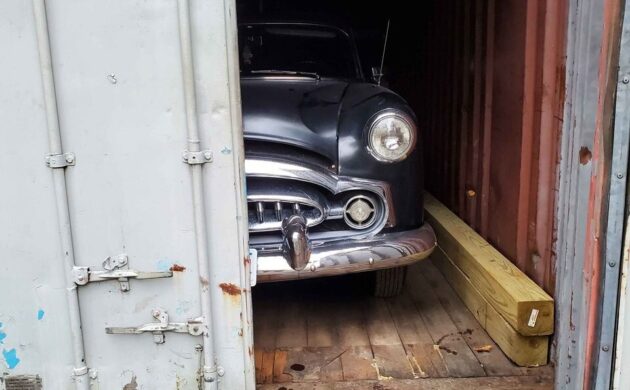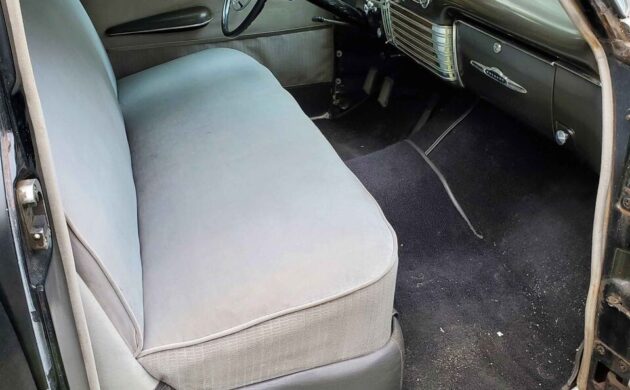In the early 1950s, Packard played the numbers game in naming its product offerings. There were the 200, 250, 300, and 400, with the 300 being the mid-range model. It was offered only in 1951 and 1952 and was strictly available as a 4-door sedan. The seller’s example from 1952 looks like a nice car that’s been hidden away in a storage container. We’re told it runs well and “goes down the road straight as an arrow” yet we’re not treated to any photos of the entire car outdoors. Another great tip from T.J., this Packard is in Sterling, Massachusetts, and is available here on Facebook Marketplace for $10,500.
By 1951, Packard was trying to distance itself from the “bathtub styling” its cars wore after World War II. And the company was still three years away from its ill-fated merger with Studebaker. For 1951-52, the 300-model rode on Packard’s 127-inch wheelbase platform. It was a step up from the 200 and 250 models and the trim level included tinted windows, a robe rail for backseat passengers, and striped interior fabrics. Outside trim included full-wheel covers and Packard’s graceful pelican hood ornament. To further differentiate the car from the 200/250, the 300 received a wrap-around rear window that it shared with the high-end 400 models.
We’re not given any background on the seller’s 300. The photos show it emerging from a storage container, but we don’t know how long it lived in there. The car is currently registered and inspected, so we assume it could be driven to and from any event you chose to take it to. Under the hood resides Packard’s venerable Super Eight engine, a 327 cubic-inch “Thunderbolt” inline-eight. This car has a 3-speed manual transmission with overdrive although Packard’s Ultramatic automatic transmission was optional.
Compared to its competitors, the production of the 300 was relatively low. In 1951, 15,309 300s were built and in 1952 the number dropped to 6,705. After that, Packard would go back to calling most of its cars by names and the 300 would become the Cavalier. This ’52 Packard is said to have 88,000 miles and might be a very nice car, but a better listing would likely attract more attention. The seller mentions having a list of work that has been done yet goes into no detail about any of it.











Packard parts!
Nooooo, don’t encourage that, if you mean part it out. Here is a car that could easily be used AS IS. It clearly wasn’t in the container long, as it shows none of the storage symptoms. Containers can be had cheap, and offer instant storage. While it sported new sheet metal, underneath, it was the same car as our 1950 which had prewar designs, one of it’s downfalls. For less money, you could have a Olds V8. I see this car does not have the Electromatic clutch, a feature my grandfathers ’48 had, and worked well, according to my dad. ’52 was the 1st year for the “downswept” wings on the hood ornament, as the upswept one, like we still have that was my grandfathers, was deemed a pedestrian hazard. Nice car, and “turn key” doesn’t really apply, as I believe you still mashed the gas pedal to start.
Was talking about the pictures. No shots of the entire car….
Howard,
As an unofficial “Packard guy” here on Barn Finds, the change in the elevation of the Cormorant hood ornament wings was done because “Longer & lower” was the latest thing in American cars. With the overall car height reduced in 1951, the front fenders considerably raised up, and the hood flattened, the 1951 wings looked too tall, even while they were identical to the 1948-50 version. Many potential 1951 Packard buyers felt the wings were too tall, opting instead for the less expensive ornaments.
There was another less known reason: If one was a juvenile delinquent [JD], a new craze had developed, and involved squeezing the 2 wings together until one or both broke off. The earlier versions fitted to Packards up thru 1947 had wings made of thick sheet steel, chrome plated, and would bend, but not break. For the 1948 and newer Cormorant ornament, they were cast pot metal, chrome plated.
With enough pressure, the wings would snap off at the base. Most [99 percent] of people were unable to break them off, but some guys were able to accomplish the task. Over the years I’ve owned, worked on, or stripped for parts, hundreds of Cormorant-bearing Packards, and only a few had “clipped wings”.
As for this car, It was equipped with the mid-level 327 engine, but with 5 main bearings instead of the 9-main 327 in the 400 sedan. This car, with overdrive, is quite quick, and a real stump puller due to the huge torque this engine produced. Based on what I see in the photos, the interior has been re-done.
That entire outer frame of the front grill is one piece cast pot metal [AKA Zamak], and as far as I can determine this part was the largest single piece of Zamak ever installed on a car. They broke very easily, and due to the Korean war restrictions on war materiel, they didn’t have copper & nickel under the chrome plating. This resulted in the grills pitting badly in the northern & eastern states.
I used to sell Packard parts, and the last time I had a NOS 1952* grill was in 1978, and I sold it BACK THEN for $800. Last I heard, a VERY nice grill [if you can find one], sells for several thousand Dollars.
* 1951, 53 & 54 grills can be modified to fit.
What a great opening photo!
Exactly what I was about to post!
One of my very first cars in 1964 was a 51 Packard with that amazingly smooth straight 8 with an automatic trans. Driving it was like sitting on the couch holding a steering wheel. What a smooth car.
I have that very one, 51 400 Patrician, 327 ultramatic, ps, pb.
I liked the anticipation from the opening photo as well. Beautiful car!
It’s truly a shame that Packards are no longer made. Quality car, but the only style I really didn’t like was the 1948-49 style
When I was about 10, my dad and I were at the Barber Shop on Old 27 in Chattooga County. We hear that siren and went outside to see what was up. One of these Packard’s was ahead of the siren and trailing way behind was a 54 Pontiac from the Trion Police Department. He could not apprehend. Later that afternoon we found out he did not make the s curve and twin bridges on HWY 27 from speeding too fast. Needless to say he did not walk away from the accident. “Old Times”
How times do change!
When older people hear I’m a Packard guy, they often tell me they love the Packard automobile story, but dislike the “Bathtub” or “Pregnant Elephant” Packards from 1948 to 1950. That said, back when those cars were new, it was a different story.
The immediate post-WW2 era was a time of fast-paced changes in technology, but for the first couple of years, car manufacturers were concentrating on production rather than styling. All of that would quickly change by 1948.
When the 1948 Packards were introduced, starting with the Packard Super convertible in late 1947*, things were very different. At that time there were 8 various styling awards in America. These awards were not just for car styling, but industrial styling, fashion, and more. That year Packard was named #1 in all 8 categories! the New York Museum of Modern Art [MOMA] set up a display inside the museum featuring a 1948 Packard Super convertible, to illustrate the new modern look in cars.
The streamlined body sides were considered quite advanced, and Packards only had a single line of stainless steel trim below the beltline [2 lines on the senior Packard Custom Eight series], and those trim lines made the car look even longer, while serving as a “break line” for the flat panels.
Back when other cars still had a vestigial rear fender curve, the less expensive cars often had a black rubber pad at the forward end of the rear fender hump, while the more expensive cars sometimes had a chromed or stainless decorative piece. Packard had neither, and didn’t need them.
The only other production car company with streamline body sides, in the same price class as the lower priced Packards, was the Frazer Manhattan, from Kaiser-Frazer Corp. But without the chrome trimline as found on the Packard, intended to break-up the perceived “bulk” of the body side, it was generally looked on as being too tall.
All that was to change rapidly. By 1950 the public’s taste had shifted away from streamlined car body sides, and the new look was “longer and lower”, and to accomplish the new look required flowing lines once again. For 1951 Packard’s chief stylist John Reinhart added an updated curve of the rear fender’s forward shape to beak up the slab side, and for the more expensive “Senior” Packard line, large chrome “gravel shields” made their appearance.
* The new 1948 Packard convertible was built on a different [but parallel] assembly line, so while the original assembly line was still making the 1947 Clipper enclosed models, the convertible line was all new and ready to start production ahead of the 1948 enclosed Packards. Because the initial “sneak previews” of the new convertible were so well received, the company elected to introduce the convertible while the Clipper cars were still in production.
Im adding a photo of the new 1948 Packard convertible assembly line.
Really interesting info., thanks Bill.
As I told the story before, my first car in 1970 was a ’50 Packard Ultramatic, a doctors car, recovered from my granddads garage. It was absolutely pristine with mohair interior, lap robe etc. Forever grateful to my strait laced Dad, who somewhere buried in his lawyers demeanor, harbored a wild enough streak to sell the car to his 16 yr old son for two hundred and fifty bucks.
A little Mystery oil in the cylinders and I was up and running…until the tranny failed.
Anyway I myself prefer the ’46-47 Packard despite my history with the ’50.
They didn’t build it for handling, that’s for sure! What were they thinking when they decided on a straight 8?? Car looks like a great deal.
Robert West,
The Packard straight eight motor dates all the way back to 1923. As Packard was noted for superior technical aspects of a motorcar, those inline 8 motors were superior for torque and lack of vibration. As a Packard owner and restorer, I have been able to balance a nickel on edge, on top of the cylinder head, on many Packard 8 motors, while the engine is AT IDLE. Over the years I’ve watched many guys try to do the same to V8 engines, but have yet to see a single nickel stay upright.
That said, Packard was late in the decision to switch to the modern V8, and while a truly excellent running engine, by 1951 the straight 8 was [based on the competition] obsolete, and that hurt the company.
I guess I’m different because I actually LIKE the looks of the 1948-50 Packard……2 door or 4 door!